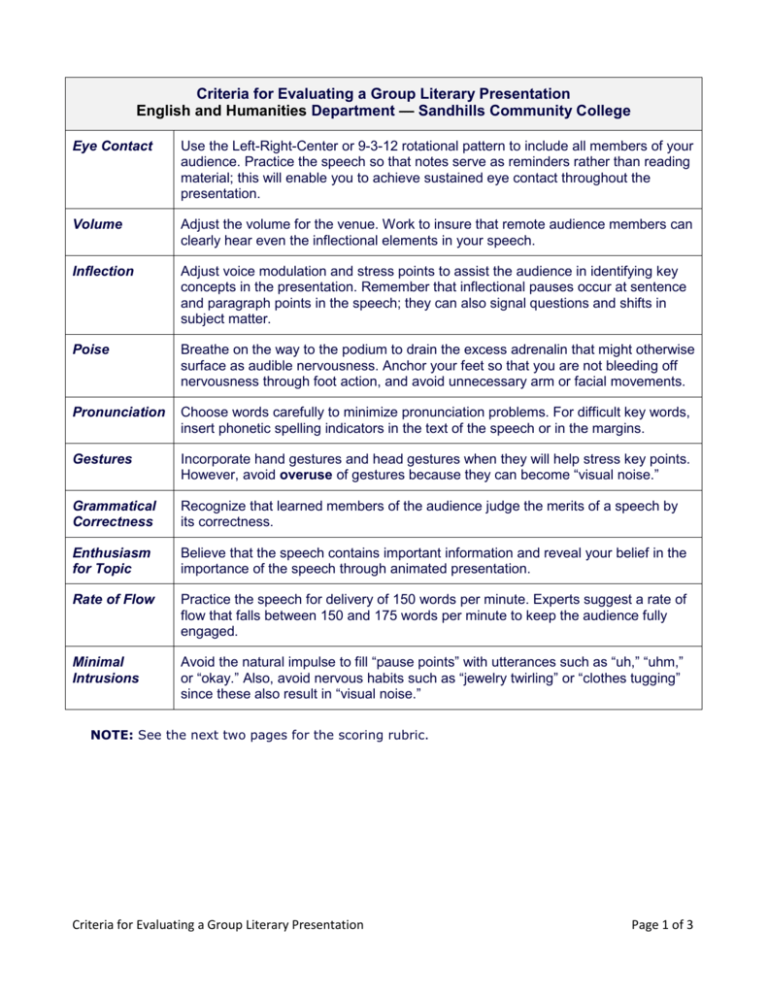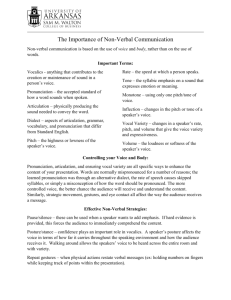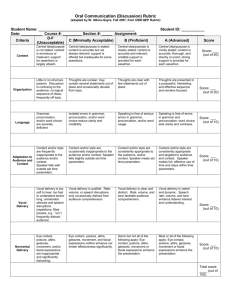MS Word document - Sandhills Community College
advertisement

Criteria for Evaluating a Group Literary Presentation English and Humanities Department — Sandhills Community College Eye Contact Use the Left-Right-Center or 9-3-12 rotational pattern to include all members of your audience. Practice the speech so that notes serve as reminders rather than reading material; this will enable you to achieve sustained eye contact throughout the presentation. Volume Adjust the volume for the venue. Work to insure that remote audience members can clearly hear even the inflectional elements in your speech. Inflection Adjust voice modulation and stress points to assist the audience in identifying key concepts in the presentation. Remember that inflectional pauses occur at sentence and paragraph points in the speech; they can also signal questions and shifts in subject matter. Poise Breathe on the way to the podium to drain the excess adrenalin that might otherwise surface as audible nervousness. Anchor your feet so that you are not bleeding off nervousness through foot action, and avoid unnecessary arm or facial movements. Pronunciation Choose words carefully to minimize pronunciation problems. For difficult key words, insert phonetic spelling indicators in the text of the speech or in the margins. Gestures Incorporate hand gestures and head gestures when they will help stress key points. However, avoid overuse of gestures because they can become “visual noise.” Grammatical Correctness Recognize that learned members of the audience judge the merits of a speech by its correctness. Enthusiasm for Topic Believe that the speech contains important information and reveal your belief in the importance of the speech through animated presentation. Rate of Flow Practice the speech for delivery of 150 words per minute. Experts suggest a rate of flow that falls between 150 and 175 words per minute to keep the audience fully engaged. Minimal Intrusions Avoid the natural impulse to fill “pause points” with utterances such as “uh,” “uhm,” or “okay.” Also, avoid nervous habits such as “jewelry twirling” or “clothes tugging” since these also result in “visual noise.” NOTE: See the next two pages for the scoring rubric. Criteria for Evaluating a Group Literary Presentation Page 1 of 3 Evaluation of Group Presentation Evaluation of Group Presentation I. EVALUATION OF SPEECH COMPONENTS (40 Points) Component Speaker One Speaker Two Speaker Three Speaker Four Possible Points Eye Contact 4 Volume 4 Inflection 4 Poise 4 Pronunciation/ Enunciation 4 Gestures 4 Grammatical Correctness 4 Enthusiasm for Topic 4 Rate of Flow 4 Minimal Intrusions 4 Points Earned Notes and Comments II. ADDITIONAL REQUIRED ELEMENTS (10 Points) Instructor may require visual aids, evidence of research, or handouts. 10 SPEECH COMPONENT SCORE 50 Criteria for Evaluating a Group Literary Presentation Page 2 of 3 III. EVALUATION OF TEXTUAL COMPONENTS (50 Points) Component Quality Possible Points Introduction This may include any of the following: A biographical sketch of the author, an overview of the group's focus and intent, an analysis of the author's importance to literature, an explanation of the cultural focus of the work, and/or the social impact of the work. 10 Narrative Profile This may include discussion of elements of exposition, rising action, and resolution for the work(s). Identification of the setting (time, place, social climate), protagonist, antagonist, complications/major conflict, and type of resolution should naturally surface in the plot analysis. 10 Textual Analysis This may include discussion of several key passages that provide evidence of the author's unique contributions to literature and/or to the reader's understanding of the author's purpose. Passages should reflect an understanding of literary devices or plot devices that lend impact to the tale. 10 Reader Reaction This may include individual and group reaction to the theme, the moral implications of the work, any social impact of the reading, the cultural biases reflected in the work, and/or the aspects of the tale that lend it a sense of timelessness or a lack thereof. 10 Question and Answer Session One or more group members answer questions related to the elements of the presentation. 10 Textual Component Score 50 Points Speech Component Score 50 Points IV. TOTAL SCORE Criteria for Evaluating a Group Literary Presentation Points Notes and Earned Comments 100 Points Page 3 of 3








